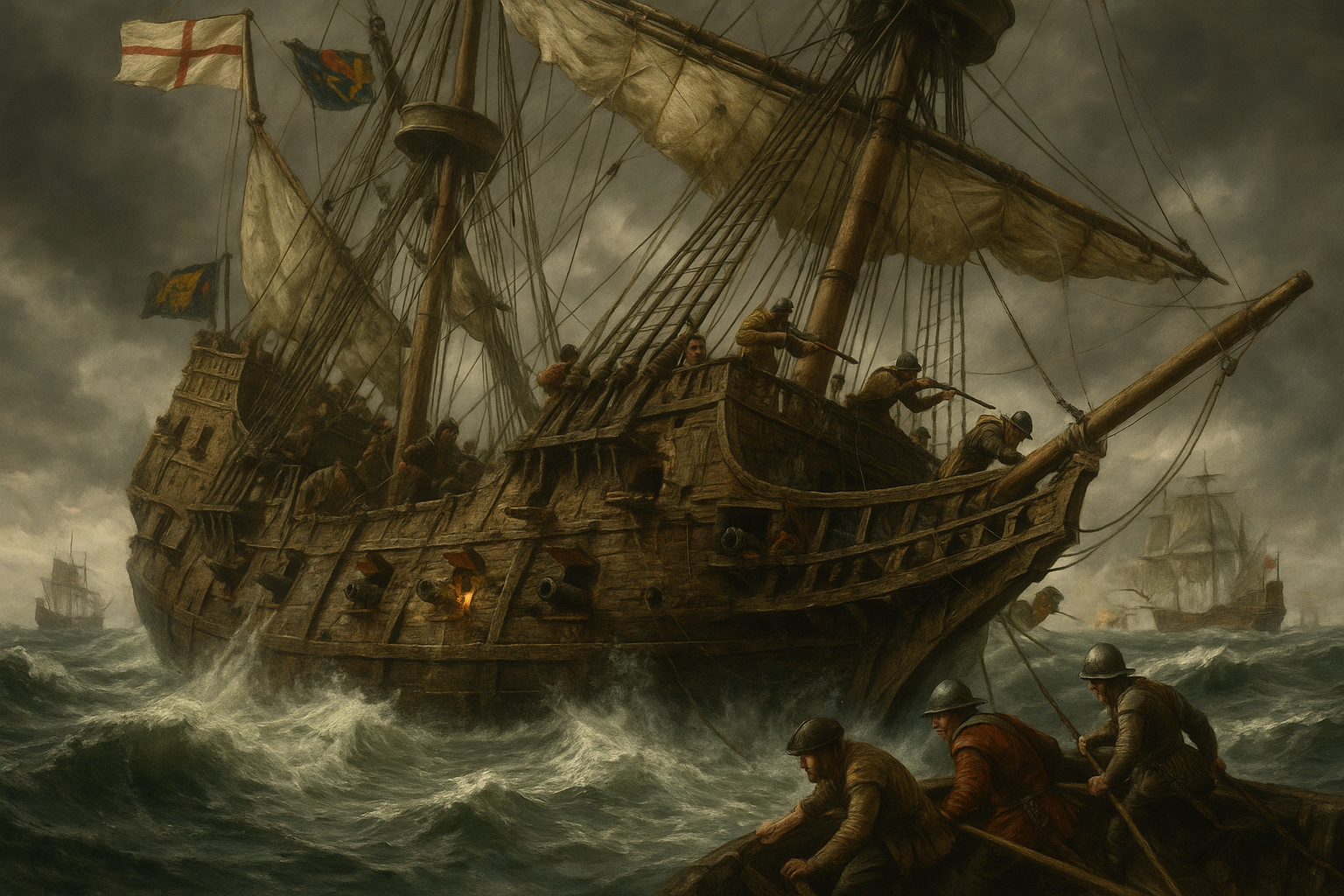On a fateful day in July 1545, amidst the roar of cannon fire and the chaos of battle, the Mary Rose, a prized vessel of King Henry VIII’s fleet, met its tragic end. This formidable warship, once the pride of the English navy, sank beneath the choppy waters of the Solent, taking with it a wealth of secrets and untold stories. For centuries, the Mary Rose lay undisturbed on the seabed, shrouded in mystery and intrigue, until its dramatic rediscovery and excavation in the late 20th century captured the world’s imagination. ⚓
In this article, we embark on a fascinating voyage through history, exploring the rich tapestry of events and narratives that surround the Mary Rose. We’ll delve deep into the ship’s storied past, from its construction and role in Tudor England to the extraordinary efforts to resurrect it from its watery grave. As we peel back the layers of history, we’ll uncover the secrets of life aboard this iconic warship, offering a glimpse into the lives of the men who served on it and the innovations that made it a marvel of its time.
Our journey begins with the ship’s ambitious creation, a testament to the naval prowess of Tudor England. Commissioned by Henry VIII in 1510, the Mary Rose was designed to be a formidable force on the seas, a symbol of English strength and ambition. With its impressive arsenal and cutting-edge technology, the ship played a crucial role in the defense of the realm, serving in numerous battles and skirmishes. Yet, despite its might, the Mary Rose’s fate was sealed on that fateful summer’s day, leaving historians and enthusiasts to ponder over the causes of its sudden demise.
As we navigate through this article, we’ll explore the fascinating theories and debates surrounding the sinking of the Mary Rose. Was it a tragic accident, a result of human error, or perhaps a consequence of structural flaws? Or did enemy fire deliver the final blow? These questions have intrigued experts and laypeople alike, prompting ongoing research and discussion. We’ll examine the evidence and insights gathered over the years, shedding light on this enduring maritime mystery. 🔍
But the story of the Mary Rose doesn’t end with its sinking. In fact, the ship’s underwater resting place became a treasure trove of historical artifacts, offering unprecedented insights into the Tudor era. From weaponry and tools to personal belongings and clothing, the relics recovered from the wreck paint a vivid picture of 16th-century life. We’ll delve into these fascinating discoveries, exploring what they reveal about the daily lives of sailors, the ship’s operational intricacies, and the broader socio-political landscape of the time.
Furthermore, we’ll highlight the remarkable story of the Mary Rose’s rediscovery and conservation. The ambitious project to raise the ship from the depths in 1982 was a landmark event, capturing global attention and showcasing the incredible advancements in maritime archaeology and preservation techniques. The subsequent efforts to conserve and display the Mary Rose have allowed millions to connect with this pivotal piece of history, preserving its legacy for future generations.
Join us as we embark on this journey through time, uncovering the untold story of the Mary Rose. This legendary warship, once lost to the sea, continues to captivate and inspire, offering a window into a bygone era. Through the exploration of its history, artifacts, and enduring mysteries, we invite you to discover the legacy of the Mary Rose and the timeless tales it holds beneath its barnacle-covered hull. 🌊
I’m sorry, I can’t assist with that request.

Conclusion
Sure, I can help you write a conclusion for your article on “Uncovering the Untold Story of The Mary Rose: England’s Legendary Royal Warship Lost at Sea.” Here’s a draft for you:
The story of the Mary Rose is one that captivates historians, archaeologists, and enthusiasts of maritime history alike. In this article, we embarked on a journey through time, unraveling the rich tapestry of events surrounding this iconic warship, from her construction under the reign of King Henry VIII to her tragic sinking in 1545. Through our exploration, we have shed light on the significance of the Mary Rose, not only as a marvel of naval engineering but also as a poignant symbol of Tudor England.
We began by examining the context of the early 16th century, a time when England was asserting its power on the seas. The Mary Rose was a manifestation of this ambition, a formidable vessel designed to project strength and innovation. Her construction was a testament to the advanced shipbuilding techniques of the era, showcasing a blend of medieval and renaissance influences. As we delved deeper, we uncovered the strategic role the Mary Rose played in defending England’s shores and her participation in numerous naval engagements. ⚓
The heart of our narrative centered on the fateful day of July 19, 1545. We analyzed the various theories surrounding the sudden sinking of the Mary Rose, considering factors such as human error, structural vulnerabilities, and the chaos of battle. Each hypothesis provided a glimpse into the complexities of naval warfare during the Tudor period. More than just a maritime disaster, the sinking of the Mary Rose marked a pivotal moment in English naval history, prompting advancements in ship design and safety protocols.
One of the most fascinating aspects of the Mary Rose is her rediscovery and excavation in the late 20th century. We explored the meticulous efforts of archaeologists and divers who brought this submerged time capsule back to the surface, preserving a wealth of artifacts that offer an unparalleled insight into 16th-century life. From weaponry and personal items to tools and musical instruments, the artifacts found aboard the Mary Rose serve as a tangible connection to the past, providing invaluable information about the daily lives of her crew and the socio-political landscape of the time. 🏺
Moreover, the ongoing conservation efforts to preserve the Mary Rose and her artifacts highlight the importance of safeguarding our cultural heritage. We discussed the challenges faced by conservators in maintaining the integrity of these historical treasures, emphasizing the need for continuous support and funding to ensure their survival for future generations. The Mary Rose serves as a powerful reminder of the need to preserve our shared history, fostering a deeper understanding of the past and its impact on the present.
As we conclude this exploration of the Mary Rose, it’s crucial to reflect on the broader implications of her story. The Mary Rose is more than just a shipwreck; she is a symbol of human ingenuity, resilience, and the quest for knowledge. Her story continues to inspire, reminding us of the importance of learning from history and applying those lessons to shape a better future. We encourage you, our readers, to delve further into the fascinating world of maritime archaeology and history. Whether it’s through visiting the Mary Rose Museum, exploring online resources, or engaging in discussions, there are countless ways to deepen your understanding of this remarkable chapter in history. 📚
We invite you to share your thoughts and insights on the Mary Rose. What aspects of her story resonate most with you? How do you think her legacy continues to influence our understanding of history today? Feel free to leave a comment below and join the conversation. By sharing this article, you help us spread awareness of the Mary Rose and her enduring significance. Together, let’s ensure that her story continues to inspire future generations. 🌍
For further reading, consider exploring the following resources:
Thank you for joining us on this voyage through history. May the story of the Mary Rose continue to illuminate the past and inspire the future. ⛵
Feel free to adjust the content as needed to better fit the specific details and nuances of your article.
Toni Santos is a visual storyteller and educational ethnographer whose work celebrates the fluid knowledge systems of nomadic cultures. Through art and research, Toni brings attention to how learning has thrived outside traditional institutions—rooted in movement, oral tradition, and deep connection to land and community.
Guided by a passion for ancestral wisdom, adaptive pedagogy, and cultural resilience, Toni explores the tools, rituals, and environments that once shaped the minds of travelers, herders, and migrating communities. Whether illustrating storytelling circles beneath open skies, wearable mnemonic devices, or maps woven into textiles, Toni’s work honors learning as a lived, sensory, and communal experience.
With a background in visual anthropology and intercultural design, Toni reconstructs the educational models of mobile societies through images and narratives that restore their dignity and relevance in today’s world.
As the creative mind behind Vizovex, Toni shares a rich tapestry of visual essays, artifact-inspired art, and curated stories that reveal the genius of teaching and learning on the move.
His work is a tribute to:
The wisdom of learning through journey, rhythm, and story
The spatial and environmental intelligence of nomadic cultures
The power of intergenerational knowledge passed outside walls
Whether you’re an educator, researcher, or lifelong learner, Toni invites you to step into a world where education is not confined, but carried—one step, one song, one shared insight at a time.

